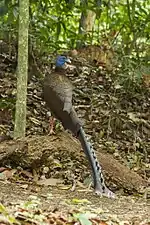Phasianinae
The Phasianinae (Horsfield, 1821) are a subfamily of the pheasant family (Phasianidae) of landfowl, the order Galliformes. The subfamily includes pheasants, tragopans, junglefowl, peafowl, and similar birds.[1] Although this subfamily was considered monophyletic and separated from the partridges, francolins, and Old World quails (Perdicinae) till the early 1990s,[1][2] molecular phylogenies have shown that the two Phasianidae subfamilies actually constitute only one lineage. For example, some partridges (genus Perdix) are more closely affiliated to pheasants, whereas Old World quails and partridges from the genus Alectoris are closer to junglefowls.[3][4]
| Phasianinae | |
|---|---|
 | |
| Mongolian ringneck-type common pheasant (Phasianus colchicus) cock | |
| Scientific classification | |
| Kingdom: | Animalia |
| Phylum: | Chordata |
| Class: | Aves |
| Order: | Galliformes |
| Family: | Phasianidae |
| Subfamily: | Phasianinae Horsfield, 1821 |
| Type species | |
| Phasianus colchicus | |
| Genera | |
| |
Phasianinae are characterised by strong sexual dimorphism, males being highly ornate with bright colours and adornments such as wattles and long tails. Males are usually larger than females and have longer tails. Males play no part in rearing the young. They typically eat seeds and some insects.
Species in taxonomic order
This list is ordered to show presumed relationships between species.
| Image | Genus | Living species |
|---|---|---|
.jpg.webp) | Ithaginis |
|
 | Tragopan |
|
 | Pucrasia |
|
 | Lophophorus, monals |
|
_Male.jpg.webp) | Gallus, junglefowl and chickens |
|
 | Lophura, gallopheasants |
|
 | Crossoptilon, eared pheasants |
|
 | Catreus |
|
 | Syrmaticus, long-tailed pheasants |
|
 | Phasianus, typical pheasants |
|
 | Chrysolophus, ruffed pheasants |
|
 | Polyplectron, peacock-pheasants |
|
%252C_Zoo_de_Ciudad_Ho_Chi_Minh%252C_Vietnam%252C_2013-08-14%252C_DD_01.JPG.webp) | Rheinardia |
|
 | Argusianus |
|
 | Pavo Peacock |
|
 | Afropavo |
|
References
- Johnsgard, P. A. (1986). The Pheasants of the World. Oxford, UK: Oxford University Press.
- Johnsgard, P. A. (1988). The Quails, Partridges, and Francolins of the World. Oxford, UK: Oxford University Press.
- Kimball, R. T.; Braun, E. L.; Zwartjes, P. W.; Crowe, T. M.; Ligon, J. D. (1999). "A molecular phylogeny of the pheasants and partridges suggests that these lineages are not monophyletic". Molecular Phylogenetics and Evolution. 11 (1): 38–54. doi:10.1006/mpev.1998.0562. PMID 10082609.
- Kimball, Rebecca T.; Braun, Edward L. (2014). "Does more sequence data improve estimates of galliform phylogeny? Analyses of a rapid radiation using a complete data matrix". PeerJ. 2: e361. doi:10.7717/peerj.361. PMC 4006227. PMID 24795852.